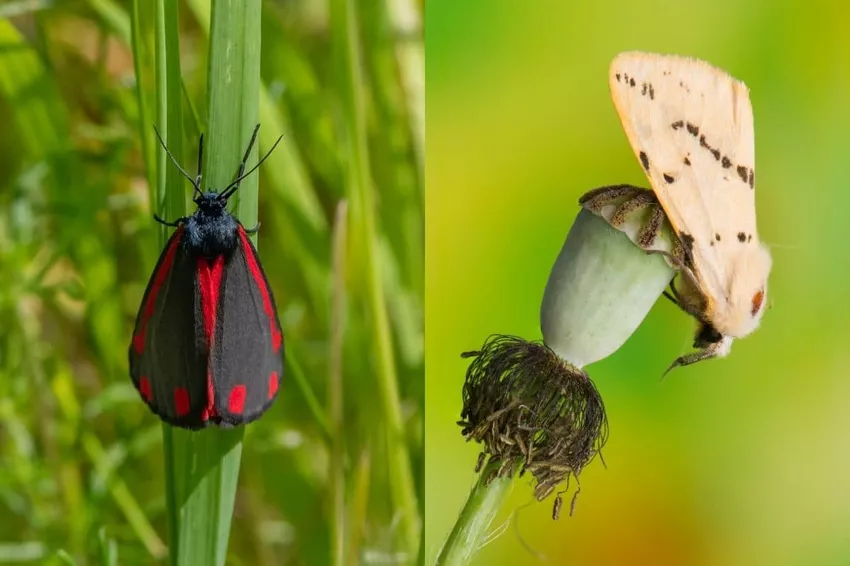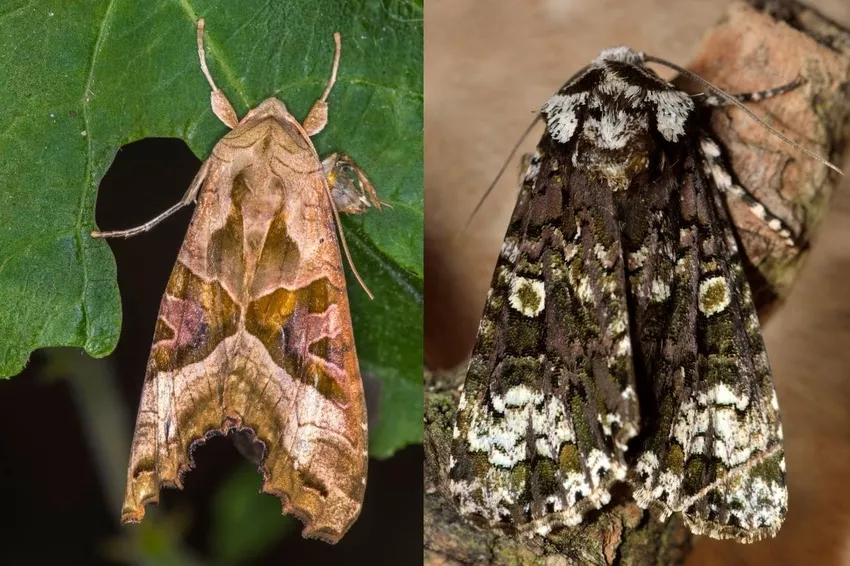- Common moth species
- Bear moth (Arctiidae)
- Birch moth (Endromidae)
- Owl moth (Noctuidae)
- Clucks (Lasiocampidae)
- Hawk-moth (Sphingidae)
- Tensioners (Geometridae)
- Slug moth (Lymantriinae)
- Ramlets (Zygaenidae)
- Tooth moth (Notodontidae)
- frequently asked Questions

Of the many butterfly species in Germany, around 95 percent are moths. Due to their mostly well-camouflaged appearance, hardly anyone notices them.
In a nutshell
- there are around 3700 butterfly species in Germany
- over 3500 of these are moths
- not all of these are actually nocturnal
- most species are well camouflaged
- some diurnal moths are also strikingly colored
Common moth species
As the name suggests, moths are mainly active at dusk and at night. This life in the dark has its advantages, because the majority of predators and food competitors are not out and about at night. Moths are usually inconspicuously colored in order to be able to camouflage themselves better during the day. The nocturnal butterflies don't even need a flashy wing color to attract a partner, because the females produce sex attractants. The male moths can perceive these pheromones from a great distance. Of course there are exceptions to this rule. Because although they are perfectly adapted to night life, a number of moth species are active during the day. There are innumerable families and subfamilies among moths. We would like to present a few of the most important ones with the typical representatives.
Bear moth (Arctiidae)
The bear moths, a subfamily of the owl moths, include not only inconspicuously colored species, but also many colorful specimens with a warning costume in the form of fiery red or bright orange hind wings. Some species even mimic the appearance of other insects, thus completely losing the distinctive appearance of a butterfly. For the most part, bear moths are nocturnal. The moths are so named because of the thick, long hairs on their caterpillars, which serve to (purely mechanically) ward off their predators.
 Left: Blood Bear; Right: Yellow spotted bear
Left: Blood Bear; Right: Yellow spotted bear
- Blood Bear/Scabbard Bear (Tyria jacobaeae)
- Brown bear (Arctia caja)
- Yellow spotted bear/yellow tiger moth (Spilosoma lutea)
- Red-collared Lichen Bear (Atolmis rubricollis)
- Russian bear (Euplagia quadripunctaria)
- Lovely bear (Callimorpha dominula)
- Plantain bear (Arctia plantaginis)
Birch moth (Endromidae)
The birch moth family includes only one species, the birch moth (Endromis versicolora). This type of moth occurs in our bright, warm birch forests, on which its caterpillars feed. From the end of February, the fox-brown butterflies hatch with the creamy-white highlights on the wings. While the male moth is diurnal, the female only flies at night. The birch moth, which has a wingspan of 50 to 70 mm, cannot take in food. For this reason, these moths usually only live for a few days and have to hurry to reproduce.
 birch moth
birch moth
Owl moth (Noctuidae)
The world's most species-rich butterfly family are the owlet moths, around 500 species are known in this country. True to their name, owl moths are almost all on the move at dusk and at night. Most species have an elongated but strong and robust build with a grey-brown pattern. The jagged owl (Scoliopteryx libatrix) is colored a little more conspicuously. Their wings contain various shades of orange and rusty red.
 Left: agate owl; Right: privet bark owl
Left: agate owl; Right: privet bark owl
- Agate Owl (Phlogophora meticulosa)
- Brown day-owl (Euclidia glyphica)
- gamma-ray owl (Autographa gamma)
- Privet Bark Owl (Craniophora ligustri)
- Arrow owl (Acronicta psi)
- Black C (Xestia c-nigrum)
Clucks (Lasiocampidae)
The moths, also known as caterpillar moths, get their name from the sitting posture of many moth species in the family. The hens wrap their front wings around their thick bodies like roof tiles, reminiscent of brooding hens. Adult hens only live a few days.
 Left: Small poplar mother hen; Right: oak moth
Left: Small poplar mother hen; Right: oak moth
- Little poplar mother hen (Poecilocampa populi)
- Clover moth (Lasiocampa trifolii)
- Oak moth (Lasiocampa quercus)
Notice: The caterpillars of the hens have stinging hairs that contain a nettle toxin.
Hawk-moth (Sphingidae)
Hawk moths are among the best fliers among butterflies. The convolvulus hawkmoth (Agrius convolvuli) manages an average speed of 50 km/h and top speeds of an incredible 100 km/h. Like hummingbirds, hawk moths suck out the nectar with their long proboscis, seemingly at a standstill, without touching the flower. One of the most well-known examples in our gardens is the dovetail (Macroglossum stellatarum). The retractable proboscis is often longer than the body of the moth itself. Many species of hawkmoth, such as the dovetail and the squirrel hawkmoth (Acherontia atropos), actually come from southern Europe or Africa and only visit us in summer for the mating season. Other special fanatics in Germany:
 Left: evening peacock; Right: Medium vine hawkmoth
Left: evening peacock; Right: Medium vine hawkmoth
- Evening Peacock (Smerinthus ocellata)
- Pine hawkmoth (Sphinx pinastri)
- Medium vine hawkmoth (Deilephila elpenor)
- Poplar Hawkmoth (Laothoe populi)
Tensioners (Geometridae)
The moths are one of the most species-rich moth families. In Germany alone, more than 400 species of moths are native, but you see them very rarely because they live quite hidden. Characteristic of the moths is their body structure, which is atypical for moths and is rather long and slender like that of butterflies. Most moths are so well camouflaged that they cannot be spotted in their habitat even if you look closely. One of the exceptions is the Yellow Moth (Opisthograptis luteolata) with its lemon-yellow wings. Almost all moths spread their wings flat when at rest, showing the hind wings.
 Left: dock moth; Right: grid tensioner
Left: dock moth; Right: grid tensioner
- Sorrel moth (Timandra comae)
- Peppered Moth (Biston betularia)
- Brown banded welt tensioner (Scotopteryx chenopodiata)
- Lattice Tensioner (Chiasmia clathrata)
- Diamond bark moth (Peribatodes rhomboidaria)
- White-tied Coniferous Forest Moth (Hylaea fasciaria)
Notice: A few species such as the lesser winter moth (Operophtera brumata) are also active in the cold season.
Slug moth (Lymantriinae)
One of the many subfamilies of the owlet moth are the slug moths. They are also referred to as harmful or woolly spinners, since some species occur as pests in agriculture and forestry. For example, there are periodic mass proliferations of the gypsy moth (Lymantria dispar), so that the infested trees or shrubs become bare.
 Left: Goldafter; Right: nun
Left: Goldafter; Right: nun
- Beech stretch foot (Calliteara pudibunda)
- Gold macaw (Euproctis chrysorrhoea)
- Nun (Lymantria monacha)
- Swan (Euproctis similis)
- Sloe brush moth (Orgyia antiqua)
Ramlets (Zygaenidae)
Many of us may have seen rams on thistles or other purple flowers without even knowing that the insects are moths. Rams, also called droplets of blood, almost all only fly when the sun is shining. Their wings do not have the characteristic moth shape, but are about twice as long as they are wide and rounded overall. Many of them have dark wings with red spots called blood droplets, which alert birds to their toxicity.
 Left: swamp horned clover; Right: Thyme willow
Left: swamp horned clover; Right: Thyme willow
- Six-spotted rampart (Zygaena filipendulae)
- Rockrose green scurvy (Adscita geryon)
- Shamrock Shamrock (Zygaena trifolii)
- Thyme willow (Zygaena purpuralis)
Tooth moth (Notodontidae)
There are almost 3,000 species of tooth spinners worldwide. Most of them live in the tropical areas. Only 34 of these moth species also occur here. The tooth spinner is named after a "tooth" pointing downwards on the inside of the front wings. Among the toothed moths, many species stand out because of their unusual caterpillar shape, which looks like tiny bizarre dragons or prehistoric animals. The best-known toothed moth is probably the oak processionary moth (Thaumetopoea processionea). Despite its inconspicuous appearance, the moth has been on everyone's lips in recent years because the stinging hairs of its caterpillars pose a health risk to humans.
 Left: beech fork tail; Right: palpal tooth spinner
Left: beech fork tail; Right: palpal tooth spinner
- Beech tooth moth (Stauropus fagi)
- Beech Forktail (Furcula furcula)
- Oak toothed moth (Peridea anceps)
- Great Forktail (Cerura vinula)
- Palpine toothmoth (Pterostoma palpina)
- Zigzag moth (Notodonta ziczac)
frequently asked Questions
How do you recognize moths?The shape of the antennae is different in moths than in butterflies. While butterflies have club-shaped antennae with a thickening at the end, the antennae of moths are pointed towards the front. Some male moths also have feathered feelers. In addition, they do not fold their wings upwards, but usually fold them back flat over their backs.
What do moths eat?Most moth species, both as caterpillars and as adults, specialize on a few plants on which they feed. However, some species do not have developed mouthparts and are therefore unable to eat at all. Their only goal is reproduction.
How old do moths get?Adult moths usually live for a few weeks. Some species without mouthparts only survive for a few days. They only keep their metabolism going through the fat stores they ate up when they were caterpillars. Butterfly species that overwinter as moths become particularly old. They often fly several months before dying.